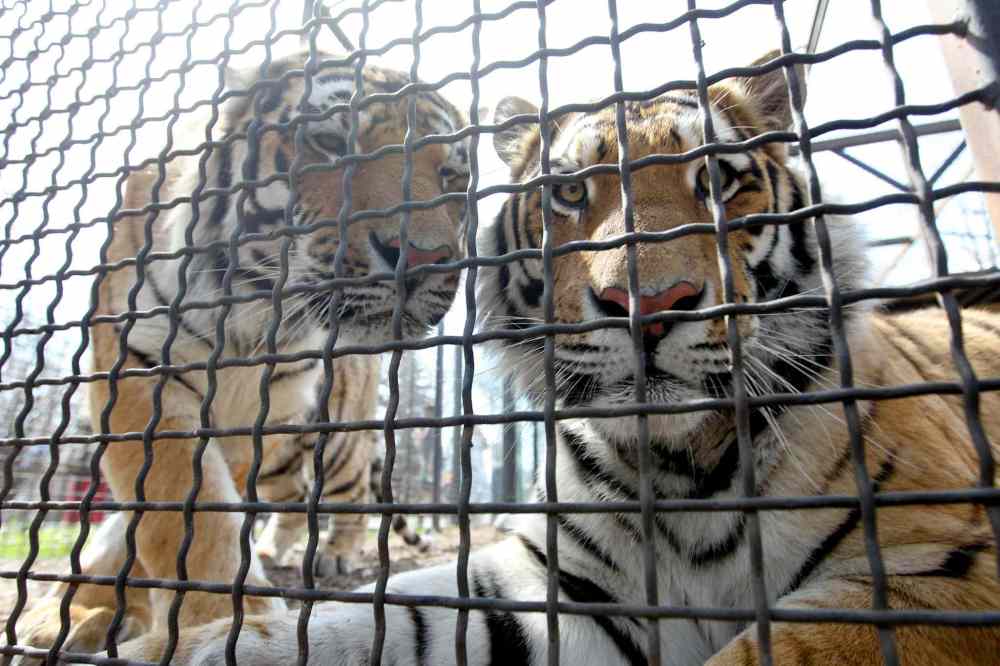Zoo has faults, but it’s not all bad
Advertisement
Read this article for free:
or
Already have an account? Log in here »
To continue reading, please subscribe:
Monthly Digital Subscription
$0 for the first 4 weeks*
- Enjoy unlimited reading on winnipegfreepress.com
- Read the E-Edition, our digital replica newspaper
- Access News Break, our award-winning app
- Play interactive puzzles
*No charge for 4 weeks then price increases to the regular rate of $19.00 plus GST every four weeks. Offer available to new and qualified returning subscribers only. Cancel any time.
Monthly Digital Subscription
$4.75/week*
- Enjoy unlimited reading on winnipegfreepress.com
- Read the E-Edition, our digital replica newspaper
- Access News Break, our award-winning app
- Play interactive puzzles
*Billed as $19 plus GST every four weeks. Cancel any time.
To continue reading, please subscribe:
Add Free Press access to your Brandon Sun subscription for only an additional
$1 for the first 4 weeks*
*Your next subscription payment will increase by $1.00 and you will be charged $16.99 plus GST for four weeks. After four weeks, your payment will increase to $23.99 plus GST every four weeks.
Read unlimited articles for free today:
or
Already have an account? Log in here »
Hey there, time traveller!
This article was published 27/11/2014 (4040 days ago), so information in it may no longer be current.
During the long period of decline when the City of Winnipeg failed to adequately fund Assiniboine Park, Winnipeg’s zoo was a major downer.
A long row of iron bird cages appeared to be a cruel apparition from the Victorian age. A pair of tree kangaroos were perched behind Plexiglass in a fake eucalyptus propped in front of a painted-on background of phony foliage.
Monkeys, marmosets and gibbons were housed within a concrete-and-steel enclosure that looked like Guantanamo Bay for primates.

The place was more than depressing.
So when the Assiniboine Park Conservancy assumed control in 2009, it was no surprise to see the biggest chunk of the park’s $200-million reconstruction devoted to the dilapidated zoo.
The largely madeover zoo, which reopened in July, houses only about a third of the animals as the old one and gives the creatures who remain more room to breathe.
During the 110 years since Winnipeg’s zoo was founded, the philosophy behind zookeeping changed from storing exotic animals within a menagerie and providing children with a source of entertainment to promoting education about wildlife conservation, environmental protection and habitat loss.
The new Assiniboine Park Zoo, which uses the Journey to Churchill sub-Arctic exhibit as its centrepiece, was redesigned with the intention of leapfrogging from a hopelessly antiquated embarrassment into one of the most innovative facilities of its kind.
Less than six months later, the zoo is reeling from a series of setbacks. First, a pack of wolves tunnelled into a polar bear enclosure. Then, some of those bears removed the caulking from a pool, shutting down an underwater-viewing area promoted as an exhibit highlight.
Far more seriously, an Amur tiger died after an altercation with another, younger tiger, following a zookeeper’s failure to keep a gate locked between the enclosures.
And this week, the zoo reported the drowning death of one of two harbour seals.
The first two incidents at the zoo could be described as growing pains for a new facility. Nobody expected wolves to tunnel into an enclosure housing one of the world’s most dangerous animals. No one predicted polar bears would go after caulking.
But the pair of animal fatalities are far more serious. The tiger’s death-by-combat was a result of human error, while the seal’s drowning resulted from an oversight.
“There was a drain I wasn’t aware of. He went back there, pushed out the grate and got sucked in,” said Assiniboine Park Zoo director Brian Joseph, a 41-year veteran zoo and aquarium administrator, as well as a volunteer marine-mammal rescuer. “You can’t imagine how bad I feel about it. I didn’t detect that area as a possible threat.”
The zoo has hired outside consultants to go over every aspect of the Journey to Churchill exhibit in an effort to ensure no other embarrassments or accidents occur. This is partly to guarantee the well-being of the zoo’s inhabitants — and partly to prevent providing any more ammunition to zoo opponents.
In some conservationist circles, there’s a belief zoos shouldn’t exist. These folks contend no animal should ever be removed from its natural habitat. That’s a respectable position, but it’s hopelessly idealistic when you consider the rate at which humanity is destroying natural habitats.
At a time when many city residents have no firsthand experience with wilderness or nature, zoos represent one of the only means of connecting kids with wildlife. People who despise zoos ignore the vital role these places play in promoting environmental education. Some zoos also perpetuate endangered species through breeding programs.
In a perfect world, we’d only observe animals in nature. But we’re destroying nature faster than we can raise awareness about the loss.
Hating on zoos thus becomes an elitist pursuit, quite literally missing the clear-cut forest for the freshly-logged trees.
This is why it’s absolutely crucial for Assiniboine Park Zoo to get its act together and avoid any more embarrassments on the scale of the death of an endangered Amur tiger, of which fewer than 400 remain in the wild.
“I’ve dedicated my life to try to make the world a better place for animals,” Joseph said. “I don’t sleep at night when things like this happen.”
Cynical zoo-haters, meanwhile, are rubbing their hands in glee. They want all zoos to fail because they ignore the ability of animals to inspire kids to grow up to become courageous adults.
bartley.kives@freepress.mb.ca
Several animals have died at the zoo in the last year. How many is too many? Join the discussion in the comments below.
History
Updated on Thursday, November 27, 2014 12:31 PM CST: Adds photo
Updated on Thursday, November 27, 2014 12:35 PM CST: adds links

